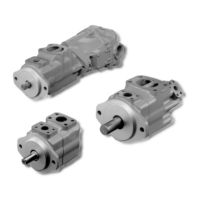8
Operating Data
Sound Levels
Average sound levels are at 138 bar
(2000 psi) using SAE 10W (26 cSt) –
(128 SUS) oil at 50C (120F).
Model - dB(A) -
1200 rpm 1500 rpm 1800 rpm
20V 62 64 66
25V 63 65 67
35V 64 66 69
45V 67 69 71
Sound levels for double pumps are on
the average 1 to 3 dB(A) higher when
both pumping sections are pressurized.
Sound levels are per NFPA T3.970.12
test standards.
Hydraulic Fluids
Use antiwear industrial hydraulic oils or
automotive crankcase oils having letter
designations SC, SD, SE or SF with
viscosity grades of 32 to 68 cSt at
40C (140
F). Preferred viscosity at
rated speed and pressures:
Minimum 13 cSt (70 SUS)
Maximum 54 cSt (251 SUS)
Minimum 49
C (120
F)
Maximum 65
C (150
F)
Cold Starts
When operating with SAE 10W oil in the
860 to 54 cSt (4000 to 251 SUS) range,
the speed and pressure should be
limited to 50% or less of their respective
rated values until the system has
warmed up. Extreme caution must be
used when starting units when fluid
viscosities are greater than 860 cSt
(4000 SUS). Care should be exercised
to warm up the entire system, including
remote cylinders and motors.
High Temperatures
Viscosities must not be less than the
respective minimum values listed for
each series of pumps. Temperatures
should not exceed 99C (210F)
because the life expectancy of cartridge
kits and elastomers will decrease.
Water-in-oil Emulsions
Water-in-oil emulsions may be used.
However, they require careful selection
and monitoring of the fluid. For
assistance contact your Vickers
representative. Soluble oil-in-water
solutions are not recommended.
Synthetic Fire Resistant Fluids
Phosphate esters and their blends with
operating viscosity of the petroleum oil
described above may be used. These
fluids are generally compatible with
fluorocarbon and silicone elastomers.
Add F3 prefix to the model code for
special seals.
For operating conditions exceeding
recommendations listed in this section,
consult your Vickers representative. For
details, refer to Vickers data sheet
I-286-S, M-2950-S or GB-B-920,
“Hydraulic Fluid and Temperature
Recommendations.”
Filtration Requirements
For satisfactory service life of
components, use full flow filtration to
provide fluid cleanliness conforming to
ISO code (see next page). Vickers OFP,
OFR and OFRS series filters are
recommended. Contact your Vickers
representative for further filtration
advice.
Drive Data
Pumps are assembled for CW or CCW
rotation. Right hand or clockwise
rotation and left hand or
counterclockwise rotation is viewed from
the shaft end.
Inlet and outlet ports remain the same
regardless of the direction of shaft
rotation. Assembly change of internal
parts is necessary, when change of
shaft rotation is required.
Pump Drive
Direct coaxial drive is recommended. If
drives imposing radial shaft loads are
considered, please consult your Vickers
representative.
Air Bleed
At the time of first-starting, if the pump
does not immediately prime, air should
be bled from the pump delivery line.
This may be accomplished by loosening
a connection in the delivery line close to
the pump until oil flows – indicating the
pump has primed. An air bleed valve is
available for this purpose.
CAUTION: – No Case Drain
The pump is drained internally into
its inlet. System pressure at the
pump inlet connection may not
exceed 1,4 bar (20 psi).
CAUTION: – Low Outlet Pressure
Do not run a pump with the outlet
pressure lower than the inlet
pressure. This causes operating
noise and vane instability.
Start-up Procedure
Make sure the reservoir and circuit are
clean and free of dirt/debris prior to
filling with hydraulic fluid.
Fill the reservoir with filtered oil and fill to
a level sufficient enough to prevent
vortexing at suction connection to pump
inlet. It is good practice to clean up the
system by flushing and filtering using an
external slave pump.
Before starting the pump, fill with fluid
through one of the ports. This is
particularly important if the pump is
above the fluid level of the reservoir.
When initially starting the pump, remove
all trapped air from the system. This can
be accomplished by loosening the
pump outlet fittings or connections
before starting the pump or by using an
air bleed valve. All inlet connections
must be tight to prevent air leaks.
Once the pump is started it should prime
within a few seconds. If the pump does not
prime, check to make sure that there are
no restrictions between the reservoir and
the inlet to the pump, and that there are no
air leaks in the inlet line and connections.
Also check to make sure that trapped air
can escape at the pump outlet.
After the pump is primed, tighten the
loose outlet connections, then operate
for five to ten minutes unloaded to
remove all trapped air from the circuit.
If reservoir has a sight gage, make sure
the fluid is clear – not milky.
Add fluid to the reservoir to bring it up to
the proper fill level.

